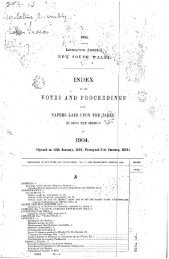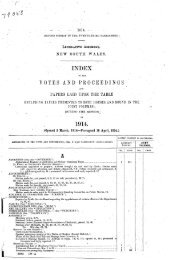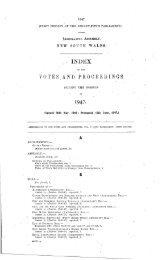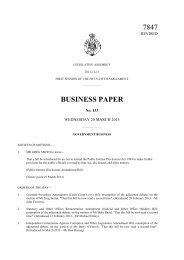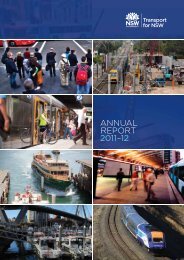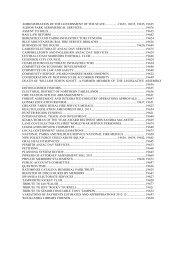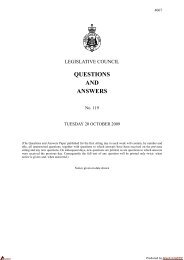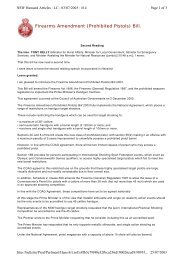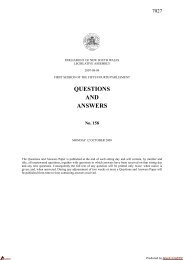Endeavour Energy Annual Performance Report - Parliament of New ...
Endeavour Energy Annual Performance Report - Parliament of New ...
Endeavour Energy Annual Performance Report - Parliament of New ...
Create successful ePaper yourself
Turn your PDF publications into a flip-book with our unique Google optimized e-Paper software.
21 Financial Instruments continued<br />
(b) Credit risk<br />
Credit risk is the risk <strong>of</strong> financial loss arising from another party to a contract, or financial position failing to discharge<br />
a financial obligation thereunder. The carrying amount <strong>of</strong> the Corporation’s financial assets represents the maximum<br />
credit exposure. The Corporation’s maximum exposure to credit risk at the reporting date was:<br />
2011<br />
$’000<br />
2010<br />
$’000<br />
Cash and cash equivalents 3,288 30,355<br />
Trade and other receivables 221,245 309,965<br />
Treasury derivatives designated at fair value through pr<strong>of</strong>it or loss – 298<br />
Treasury derivatives classified as cash flow hedges 1,149 1,376<br />
Electricity derivatives classified as held for trading – 70,481<br />
Electricity derivatives classified as cash flow hedges – 390<br />
Total exposure to credit risk 225,682 412,865<br />
<strong>Endeavour</strong> <strong>Energy</strong>’s Treasury function control risk through the use <strong>of</strong> external credit ratings which are used to derive<br />
risk limits as approved by the Board <strong>of</strong> Directors, and monitoring procedures. <strong>Endeavour</strong> <strong>Energy</strong> does not have any<br />
significant exposure to any individual customer or counterparty outside Board approved counterparty limits.<br />
Credit risks from derivative contracts (excluding electricity derivatives) recognised in the Statement <strong>of</strong> Financial<br />
Position is minimised due to <strong>Endeavour</strong> <strong>Energy</strong> having policies in place which prevent excessive counterparty<br />
concentration, and limit individual counterparty exposure based on an assessment <strong>of</strong> individual counterparties<br />
credit worthiness.<br />
<strong>Endeavour</strong> <strong>Energy</strong> no longer has credit risk in relation to electricity derivative contracts, as the risks and rewards<br />
<strong>of</strong> electricity derivative contracts have been transferred to Origin <strong>Energy</strong> through a Pass Through Agreement<br />
entered into as part <strong>of</strong> the sale <strong>of</strong> the Retail business.<br />
Financial assets which are neither past due nor impaired have been transacted with approved creditworthy<br />
counterparties in accordance with Board approved financial risk management policies, and are assessed on a<br />
continual basis.<br />
(c) Price Risk<br />
(i) Electricity price risk<br />
Price risk is the risk that <strong>Endeavour</strong> <strong>Energy</strong>’s cash flows will be adversely affected by the movements in commodity<br />
prices that will increase the Australian dollar value <strong>of</strong> commodity payables. <strong>Endeavour</strong> <strong>Energy</strong> was exposed to price<br />
risk through electricity purchasing within the National Electricity Market (NEM) pool up to the sale completion date<br />
(1 March 2011). Upon sale <strong>of</strong> the Retail business, <strong>Endeavour</strong> <strong>Energy</strong> ceased the purchase and sale <strong>of</strong> electricity and<br />
is no longer exposed to variability in electricity prices.<br />
Prior to 1 March 2011, <strong>Endeavour</strong> <strong>Energy</strong> purchased electricity from the NEM pool to meet customer load<br />
requirements. Price risk arose from the purchase <strong>of</strong> electricity at variable pool prices in the NEM. <strong>Endeavour</strong> <strong>Energy</strong>’s<br />
Board used a combination <strong>of</strong> risk management tools such as swaps, options and futures contracts transacted with<br />
market participants and energy trading operators to hedge the customer load and control exposure to NEM pool<br />
prices. Trading was performed under Board approved mandates which permitted active portfolio management<br />
within regularly monitored risk limits. The limits considered measurements <strong>of</strong> cash flow at Risk and Earnings at Risk,<br />
accompanied by Volumetrics Position Analysis.<br />
<strong>Endeavour</strong> <strong>Energy</strong> <strong>Annual</strong> <strong>Performance</strong> <strong>Report</strong> 2010–11<br />
81



